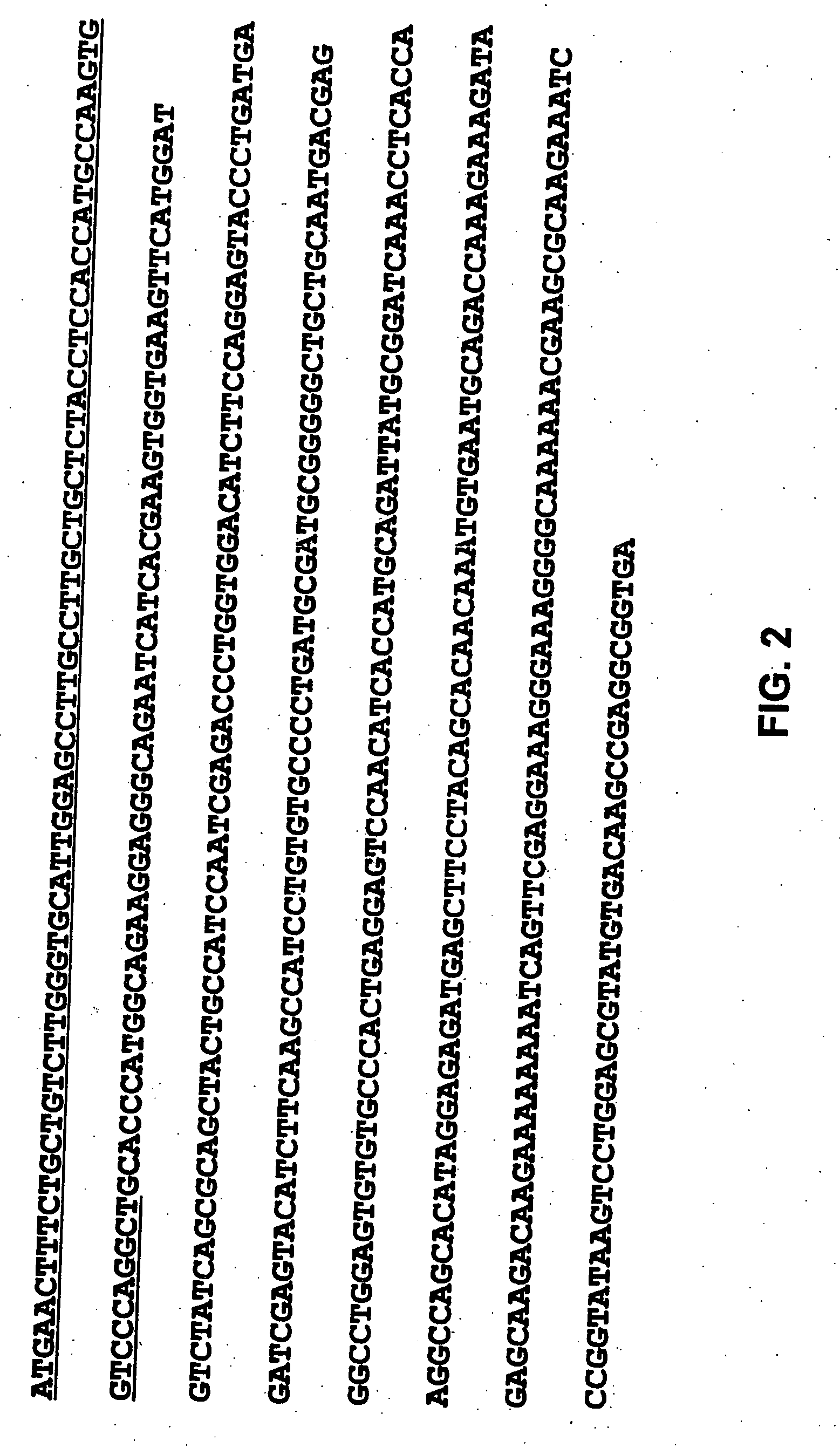Angiogenic factor and use thereof in treating cardiovascular disease
- Summary
- Abstract
- Description
- Claims
- Application Information
AI Technical Summary
Benefits of technology
Problems solved by technology
Method used
Image
Examples
example i
Isolation and Characterization of VEGF145
[0143] Reverse PCR analysis of mRNA from OC-238 human epithelial ovarian carcinoma cells as well as HeLa cells and A431 cells (FIG. 5) detected a VEGF mRNA form corresponding in size to the predicted size of a VEGF mRNA form encodind a putative mature protein of 145 amino-acids. A reverse PCR product from OC-238 cells was sequenced and found to contain the exon structure 1-5, 6a, 8 which is the expected structure of a mRNA encoding VEGF145. The cDNA which was sequenced was obtained using the primers GGAGAGATGAGCTTCCTACAG (SEQ ID No. 3) and TCACCGCCTTGGCTTGTCACA (SEQ ID No. 4), corresponding to the sequences encoding amino-acids 92-98 of VEGF (common to all VEGF forms) and to the six carboxyl-terminal amino-acids of VEGF encoded by exon 8 of the VEGF gene. In all these cell lines the putative 145 amino acid-encoding cDNA appeared to be expressed at levels comparable to those of VEGF165 and higher than those of VEGF189. The mRNA encoding this ...
example ii
Proliferation of Endothelial Cells and Angiogenesis
[0146] To confirm that VEGF145 can induce angiogenesis in vivo, the VEGF145 cDNA was subcloned into the Bam-HI site of the mammalian expression vector MIRB using the technique described by Macarthur, C. A., et. al. Cell Growth Differ. 6, 817-825, 1995, which is incorporated herein by reference. The MIRB / VEGF145 plasmid was transfected into BHK-21 hamster kidney derived cells, and stable cell lines producing VEGF145 isolated. The VEGF145 produced by the mammalian cells was biologically active and was secreted into the growth medium. A stable clone producing 0.1 mg VEGF145 per 106 cells was isolated. The VEGF145 expressing cells were embedded in alginate beads, and the beads were implanted under the skin of balb / c mice using the method described by Plunkett, M. L., et. al. Lab. Invest. 62, 510-517, 1990, which is incorporated herein by reference. Alginate pellets containing the entrapped cells were removed after four days and photogr...
example iii
Receptor Binding Characteristics
[0147] VEGF165 binds to three VEGF receptors on HUVEC cells while VEGF121 only binds to the larger of these receptors. The common receptor to which both VEGF121 and VEGF165 bind is the KDR / flk-1 VEGF receptor (Gitay-Goren, H., et. al. J. Biol. Chem. 271, 5519-5523, 1996). In order to determine the receptor recognition pattern of VEGF145. 125I-VEGF165 (produced as described in Gitay-Goren, H., et. al. J. Biol. Chem. 271, 5519-5523, 1996, incorporated by reference herein) was bound to HUVEC cells in the presence of 1 μg / ml of heparin and increasing concentrations of VEGF145. Bound 125I-VEGF165 was subsequently covalently cross-linked to the VEGF receptors. VEGF145 inhibited the binding of 125I-VEGF165 to the KDR / flk-1 receptor of the HUVEC cells but not to the two smaller VEGF165 specific receptors of the cells (FIG. 7). This result was verified in a cell free binding experiment in which VEGF145 competed with 125I-VEGF165 for binding to a soluble fusio...
PUM
| Property | Measurement | Unit |
|---|---|---|
| Length | aaaaa | aaaaa |
| Permeability | aaaaa | aaaaa |
| Cell proliferation rate | aaaaa | aaaaa |
Abstract
Description
Claims
Application Information
 Login to view more
Login to view more - R&D Engineer
- R&D Manager
- IP Professional
- Industry Leading Data Capabilities
- Powerful AI technology
- Patent DNA Extraction
Browse by: Latest US Patents, China's latest patents, Technical Efficacy Thesaurus, Application Domain, Technology Topic.
© 2024 PatSnap. All rights reserved.Legal|Privacy policy|Modern Slavery Act Transparency Statement|Sitemap



